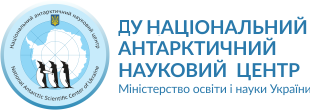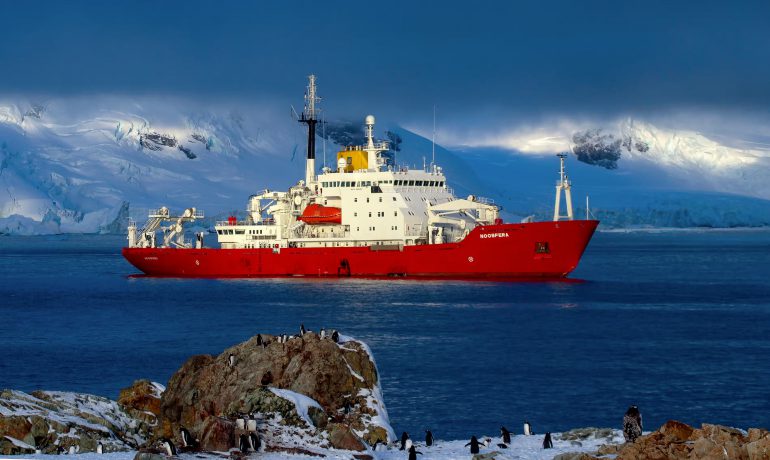Оригінал на “The Guardian” від 29.03.2024
Автор: Janie Hampton

When the research team at Vernadsky base are not defending their homeland, they are on the frontline of the climate crisis
When Ukraine’s Antarctic research and supply vessel Noosfera left Odesa on its maiden voyage on 28 January 2022, it passed Russian warships in the Black Sea. A month later, Vladimir Putin launched Russia’s full-scale invasion of its neighbour. Noosfera has not been back since.
“A few weeks later, and Noosfera would have been an important symbolic target for Russia,” said Vadym Tkachenko, a biologist who recently completed his second Antarctic winter at Ukraine’s Vernadsky base. The ship now supplies both Ukrainian and Polish Antarctic bases from Chile and South Africa twice a year, at the start and end of the winter.
Last week it crossed Drake Passage into the Southern Ocean and arrived with the 29th team of Ukrainian Antarctic scientists to be stationed at Vernadsky.
The base commander, Bogdan Gavrylyuk, has just completed his 18th tour and 10th winter in the Antarctic. He trained first as a soldier, then as a mechanic at Vernadsky. He then retrained as a geophysicist at the Institute of Radio Astronomy in Kharkiv and conducts research on electro-magnetism.
In three weeks, he will see his family for two days before returning to the frontline as a captain in the border guard. He has not been home for three years, but he is proud of his two jobs. “I was on the border in trenches and dugouts. Here, I’m on the border between what we know and what we’re learning. This is a very special place.”
The ice is melting faster than ever before, and it rains when it used to snow – Bogdan Gavrylyuk, Vernadsky base commander

The base’s origins lie in the breakup of the USSR in 1991, when Russia kept the 12 Soviet Antarctic bases. But a third of the 12,000 specialist Antarctic scientists were from Ukraine, and they had nowhere to go.
Shortly afterwards, the British Antarctic Survey decided it no longer needed its Faraday base, on a rocky island on the Antarctic peninsula, 700 miles south of Tierra del Fuego. It was sold to Ukraine for a symbolic £1 in 1996 and renamed after the Ukrainian scientist Vladimir Vernadsky.
The only condition attached to the Vernadsky base was that the Ukrainians continued to monitor the weather, which has been recorded every three hours at the site since 1947. This is the longest continuous meteorological study in the Antarctic and has demonstrated unequivocally the increase in average temperatures, which now rarely fall below -20C (-4F).
“The ice is melting faster than ever before, and it rains when it used to snow,” says Gavrylyuk. “Last year for the first time ever there was no ice around the island.” The average temperature has risen by 3.5C (6.3F).

Weddell seals need sea ice and no longer breed around the base; and invasive bacteria and algae have been found in the sea. The view from Gavrylyuk’s office is a colony of Gentoo penguins that previously nested farther north, the air filled with their fishy smell and shrieks.
This year’s chicks stand still as their fluffy feathers moult; others dash around, chasing each other for food, leaping in and out of the water like a Disney cartoon. “The first breeding pair came in 2008, we now have 1,500 pairs of adults and over 2,000 chicks,” he says.
The war may be geographically distant but for those on the base it is never far away. When news of the Russian invasion reached Vernadsky, the marine biologist Andrii Zotov hitched a lift on a yacht to Argentina, took a bus to Chile, flew to Poland and within two weeks was with an army unit on the frontline in Ukraine.
“He took five bullets and was too heavily injured to fight more,” says Tkachenko. “He returned to work on phytoplankton at the National Antarctic Scientific Centre in Kyiv. He will be back here for the handover.”
Tkachenko, meanwhile, is looking forward to meeting his first baby, born two months ago. In 2019, his wife, Oksana Savenko, an expert on humpback whales, became one of the first women in more than 20 years to live on the base. While women have historically been heavily under-represented on Antarctic research stations, in this expedition team there will be four women: three scientists and a doctor.

The base is a working complex of corrugated-iron housing and laboratories, machinery, tanks and radio masts. A wooden church, with the dimensions and bright colours of a beach hut, overlooks the generator building.
Inside, a school desk acts as the altar, a dried-milk tin holds holy water, and posters of Jesus and Saint Vladimir adorn the chipboard walls. Unlike the Russian base on King George Island, 300 miles north in the South Shetlands, there is no priest here, only scientists, engineers and a cook.
Below a round trap door in the lab block’s roof sits “Virginia”, as the Dobson spectrophotometer, which measures the ozone layer, was christened by British scientists. It was here in 1985 that a hole in the ozone was first identified by its predecessor, “Daphne”. Since the banning of CFC chemical aerosols and fridges, the hole has stabilised, but monitoring it remains essential.
In the long, dark Antarctic winters between March and October, the team socialise in the Faraday bar, a replica of an English village pub, complete with pool table and dartboard. Gavrylyuk is a talented musician who every winter writes songs about whales, seals and even plankton.

But now his guitar sits idly in the corner. “People might think this is a part of Ukraine that is at peace. The war is here too, for us and our families. Since the invasion of my home, I cannot play or sing,” he says sadly. “Only when we have peace again can I sing.”
Very few visitors and no tourists have been permitted to land at Vernadsky base since the pandemic. “We have too much work to do,” says Gavrylyuk. But he has welcomed Dr John Shears, a polar geographer, environmental scientist and recipient of the Polar Medal.

Shears worked here in 1991 and last visited Vernadsky as an Antarctic Treaty inspector in 2015. “Not much has changed since I was last here, but it’s definitely warmer,’” says Shears.
Biosecurity is strict: no organic matter, food or drink can be carried by visitors to the bases or beaches. Avian flu arrived on the Antarctic mainland last month. Initially found in scavenging skua birds, it has killed penguins and seals.
Since 1996, Ukraine has added more research into water quality, seals, whales, krill and phytoplankton – the building blocks of all sea life, and essential for global oxygen production and carbon dioxide absorption. All are affected by global warming and pollution.
Some Ukrainians believe government funds would be better spent on the war in Ukraine. But its president, Volodymyr Zelenskiy, appreciates that the Vernadsky base reminds the world that Ukraine is a global player in science, which contributes to our understanding of the climate crisis, and not just a victim of Russia’s invasion.



